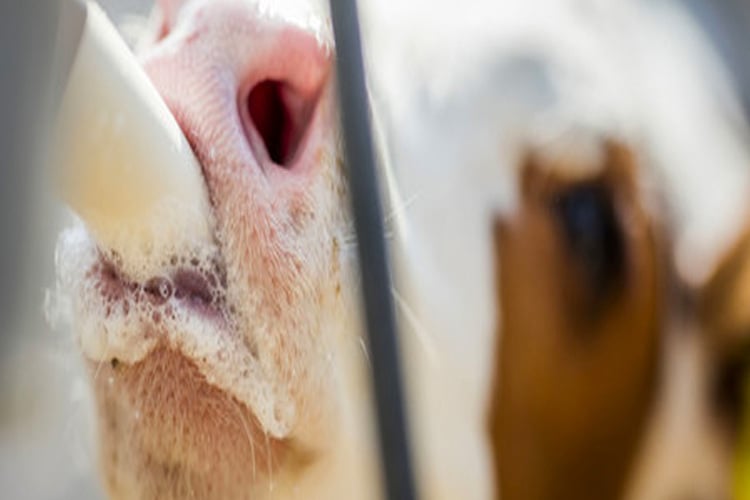Key takeaways from the research:
-
A LifeStart feeding schedule with energized calf milk containing 25% fat increased pre-weaning average daily gain by 103 g/day
-
Calves in the LifeStart group had a lower age at first insemination and a higher conception rate

Elevated planes of energized calf milk resulted in higher growth, a reduction of age at first insemination and a higher conception rate
The quality of early life nutrition in dairy calves has a big impact on pre-weaning daily gain[1,2,3,4,5,6,7,8,9,10]. Increased pre-weaning growth as a result of pre-weaning feeding schedules with elevated planes of nutrition results in improved fertility[5,9,10], which is one of the reasons that these schedules result in an increase in average lifetime daily gain.
Fat levels in traditional calf milk replacers can be significantly lower than those of whole milk. Energized calf milk replacer with a composition close to that of whole milk was compared to a traditional calf milk replacer[11].
Study design
A group of 60 calves was fed energized calf milk (ECM) with 25% crude fat from birth until they were weaned at 63 days of age. The amount of energized calf milk replacer fed over the entire period of 63 days was 43.6 kg. A control group was fed a traditional calf milk replacer with 18% crude fat and a total amount of 34.1 kg and also weaned at 63 days of age. Both groups had ad libitum access to the starter feed. Calves were weighed at 63 days and 91 days of age and intake of starter feed and fertility parameters were recorded.
Results
The average daily gain between birth and day 63 in the ECM group was 673 g/day vs. 567 g/day for the control group. Between birth and day 91, ADG in the ECM group was 854 g/day vs. 764 g/day for the control group. Starter intake was not different between the 2 groups with an intake of 20.6 kg for the ECM group vs. 19.6 kg for the controls.
The age at 1st insemination went down from 13.7 months for the controls to 12.4 months for the ECM group, with a conception rate at 1st insemination of 73.4% for the ECM group vs. 62.0% for the controls.
References
[1] Shamay, A., D. Werner, U. Moallem, H. Barash, and I. Bruckental. 2005. Effect of nursing management and skeletal size at weaning on puberty, skeletal growth rate, and milk production during first lactation of dairy heifers. J. Dairy Sci. 88:1460–1469
[2] Faber, S. N., N. E. Faber, T. C. McCauley, and R. L. Ax. 2005. Case study: Effects of colostrum ingestion on lactational performance. Prof. Anim. Sci. 21:420–425.
[3] Davis Rincker LE, VandeHaar MJ, Wolf CA, Liesman JS, Chapin LT and Weber Nielsen MS, Effect of intensified feeding of heifer calves on growth, pubertal age, calving age, milk yield, and economics. J. Dairy Sci 94:3554-3567 (2011).
[4] Moallem, U., D. Werner, H. Lehrer, M. Zachut, L. Livshitz, S. Yakoby, and A. Shamay. 2010. Long-term effects of ad libitum whole milk prior to weaning and prepubertal protein supplementation on skeletal growth rate and first-lactation milk production. J. Dairy Sci. 93:2639–2650.
[5] Raeth-Knight, M., H. Chester-Jones, S. Hayes, J. Linn, R. Larson, D. Ziegler, B. Ziegler, and N. Broadwater. 2009. Impact of conventional or intensive milk replacer programs on Holstein heifer performance through six months of age and during first lactation. J. Dairy Sci. 92:799–809.
[6] Drackley, J. K., B. C. Pollard, H. M. Dann, and J. A. Stamey. 2007. First-lactation milk production for cows fed control or intensifi ed milk replacer programs as calves. J. Dairy Sci. 90(Suppl. 1):614.
[7] Terré, M., C. Tejero, and A. Bach. 2009. Long-term effects on heifer performance of an enhanced growth feeding programme applied during the pre-weaning period. J. Dairy Res. 76:331–339.
[8] Soberon F, Raffrenato E, Everett RW and Van Amburgh ME. 2012. Preweaning milk replacer intake and effects on long-term productivity of dairy calves. J. Dairy Sci. 95:783-793.
[9] Bar-Peled et al., 1997. Increased weight gain and effects on production parameters of Holstein heifer calves that were allowed to suckle from birth to six weeks of age. J. Dairy Sci; 80:2523-8.
[10] Bolt, A. 2019, Meta-analysis to calculate the effect of rearing intensity on functionality of dairy cows, Research paper Mecklenburg Vorpommern Landesforschungsanstalt für Landwirtschaft und Fischerei.
[11] Heras Sánchez, J, Effects of feeding a calf milk replacer with elevated levels of fat on average daily gain and fertility, 2020, Proceedings of the second European Calf Conference.



